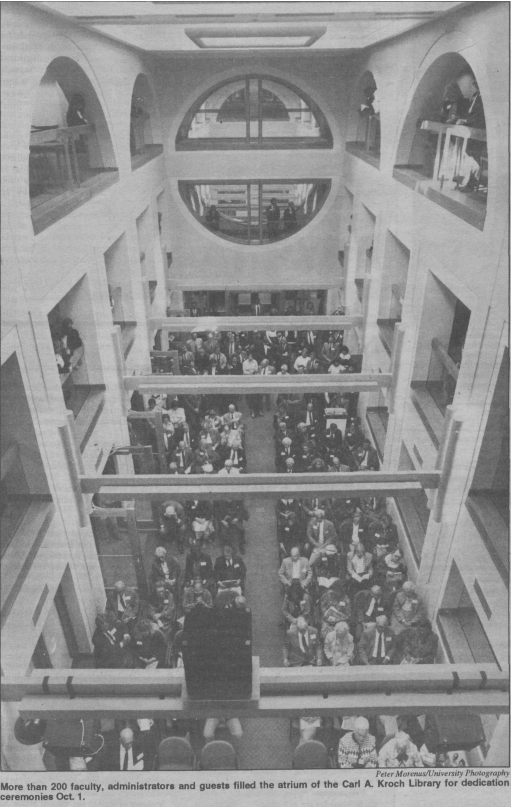🔎A Glimpse Down into Kroch Library
Delve into a brief history of how Cornell’s Kroch Library came to be.
Kroch Library, named after the Cornell ‘35 alumnus Carl A. Kroch, was opened to the public sometime in August in 1992; it is located on central campus and sits adjacent to Olin Library. One of its most distinguishing features is its architecture: it sinks three-stories underground, has a massive atrium, and four skylights that provide ample natural light. It is a resource to students from all academic backgrounds who come to study or do research. The library houses Cornell’s vast Division of Asia Collections, and the university’s invaluable Division of Rare and Manuscripts Collections. The Cornell library directory states that Kroch is approximately 97,000 square feet and contains around 1.3 million volumes and 20,000 cubic feet of manuscript material. Let that sink in… over a million volumes and countless rare manuscript material is readily available for any Cornell student, faculty, and even visitors to access!
The residing Cornell president at the time, Frank Rhodes, went so far to praise Kroch as an “extension of Cornell’s heart” after its grand opening (Cornell Daily Sun 1982). This statement is a testament to the immense impact that Kroch library would have on the university.
🏛Building Kroch
When asked about the construction process, Carl A. Kroch is reported saying "I enjoyed seeing it go from a hole in the ground through construction to this — a completed library filled with books” (Cornell Daily Sun 1982). Why did the Cornell administration decide to make a “hole in the ground” instead of building it above ground like other libraries scattered throughout the university? Records indicate that there was a push by alumni for this decision. Cornell alumni wanted to preserve the image and historical significance of the Arts Quad, so President Rhodes appeased them by building Kroch underground.
Building Kroch Library and adding it to Olin was a tumultuous process to say the least. Rumor has it (and records confirm) that dynamite was used to blast through approximately 80,000 feet of dirt! After that explosive process, the builders used a bottom-up method in order to create a sturdy foundation for the library. One of the advantages and motivations of building Kroch underground was that it would serve a functional purpose of storing the rare manuscripts; specifically, being underground adds a layer of security and provides a climate-controlled vault for storage.
📚Legendary Bookseller Carl A. Kroch
The name Carl Kroch appears a couple of times already, so who was he? Kroch comes from a family of Austrian immigrants. His own father owned a German bookstore in Chicago during the early twentieth century, this likely influenced Kroch’s career path. As you can already guess, he was heavily involved in the creation of Kroch Library (so much so the library was named after his likeness). Kroch contributed approximately 10 million dollars for the construction of the library. He claims that his love for books and history motivated this donation (or maybe he just wanted a building named after him). Regardless of his motivation, Kroch’s massive financial contribution undoubtedly led to one of the most diverse and in-depth collections of books and rare materials that Cornell has to offer.
Outside of Cornell, Kroch’s reputation as a legendary bookseller followed him. Dubbed a “hero of American culture” by the prestigious Library of Congress in 1986, he was a trailblazer in the world of literature. At some point during his lifetime, he owned the largest privately owned bookstore company in the United States. Kroch’s legacy and apparent love for books lends credence to his motivation of financing the construction of Kroch Library.
💡Visiting Kroch
One of the most compelling reasons to visit Kroch is to obtain access to its vast and massive collection of books and rare manuscripts. These resources connect us to the past whether it be cruising the Asia Collection or descending into the archives, the library has so much to offer. In addition, the librarians constantly hold exhibitions throughout the semester that highlight topics ranging from literary classics to liberal arts; for example, as of the time of this article there are two currently two in-person exhibits: Visions of Dante and Electrifying Music: The Life and Legacy of Robert Moog.
By Alberto Puente
CC Content Writer
Hi everyone! My name is Alberto. I am a senior in Arts and Sciences double majoring in Economics and Government. In my free time, you can catch me doing a variety of things: binge-watching Studio Ghibli films, creating new Spotify playlists, or listening to murder mystery podcasts. I can be reached at ap857@cornell.edu :)
Did you enjoy this blog post?✨
Continue to interact with Cornell Creatives by engaging with our social media.





